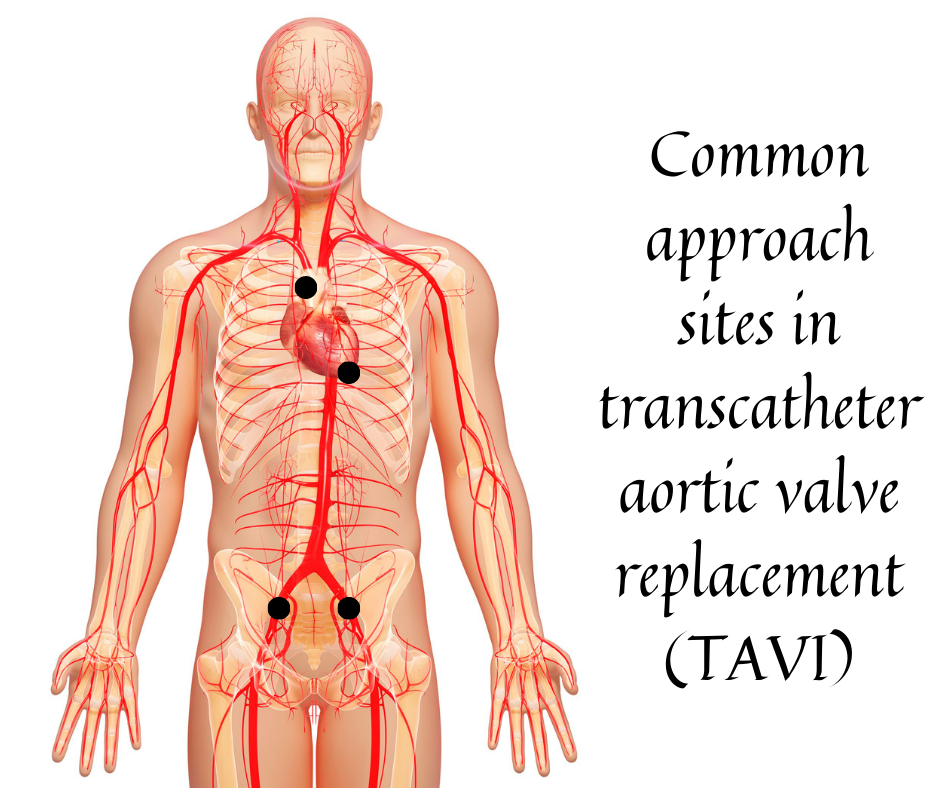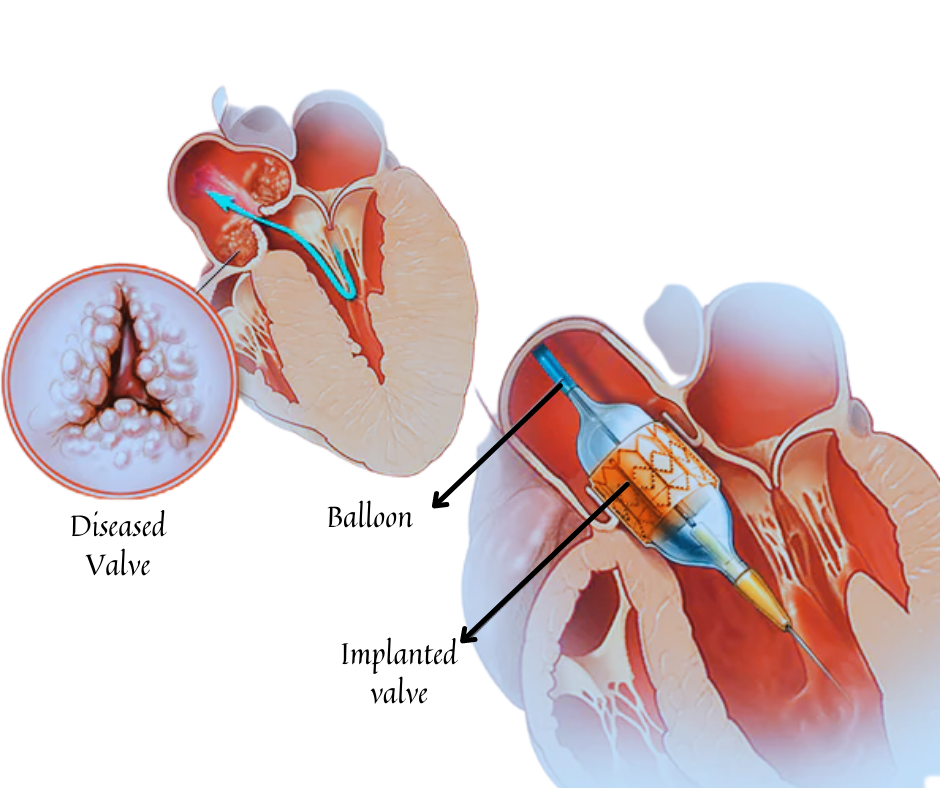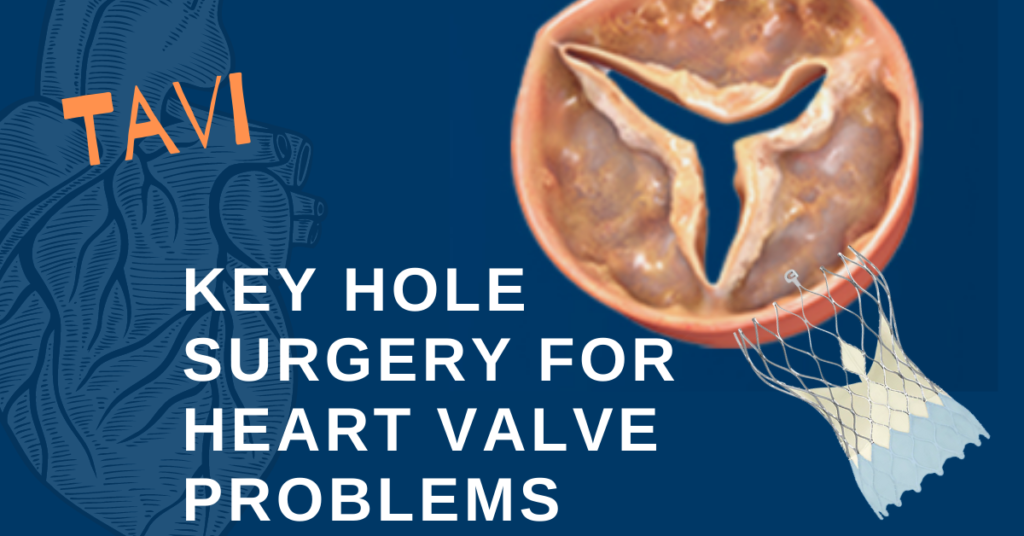Keyhole Transcatheter aortic valve replacement is also known as TAVI, is a percutaneous cardiac treatment to replace a thickened aortic valve that can’t completely open (aortic valve stenosis). This condition causes decreased Blood flow from the heart to the body
Aortic valve stenosis can cause chest pain, shortness of breath, fainting, and exhaustion. Keyhole Transcatheter Aortic Valve Replacement can help restore blood flow and minimise the signs and symptoms of aortic valve stenosis.
People who are at high risk for surgical aortic valve replacement (open-heart surgery) may benefit from TAVI. Aortic stenosis is treated with TAVI after a conversation with a team of heart and heart surgery specialists who collaborate to determine the best treatment choice for patients.
See how transcatheter aortic valve replacement is performed
Purpose of Keyhole Transcatheter Aortic Valve Replacement (TAVI)
Keyhole Transcatheter aortic valve replacement (TAVI) is a treatment for aortic valve stenosis. Aortic valve stenosis, occurs when the aortic valve of the heart thickens and stiffens (calcium deposition). As a result, the valve is unable to fully open, Which limiting blood flow to the body.
TAVI is a procedure that replaces the aortic valve without requiring open-heart surgery. TAVI patients often spend less time in the hospital than those who receive surgical aortic valve replacement.
If you have any of the following conditions, your doctor may consider TAVI:
Aortic stenosis with severe signs and symptoms.
A biological tissue aortic valve that isn’t functioning properly.
Another health problem that renders open-heart valve replacement surgery too dangerous, such as lung or kidney disease.
Risks
Every surgery and medical procedure carries some level of risk. The following are some of the potential dangers of Keyhole transcatheter aortic valve replacement (TAVI)
Complications of the blood vessels
Blood loss
Valve falling out of place or leaking (regurgitation)
Brain Stroke
Heart rhythm problems
Kidney disease
Infection, Death
Preparation for Keyhole Transcatheter Aortic Valve Replacement Surgery (TAVI)
Instructions on how to prepare for keyhole transcatheter aortic valve replacement (TAVI) will be provided by the treatment team. If you have any concerns regarding the operation, speak with your doctor.
Prior to the operation,
An Intravenous line will be inserted into your forearm or hand by a Nurse/Doctor, and you may be given a sedative to help you calm. The IV can also be used to provide anticoagulant medication to avoid blood clots. and also medication to help you avoid becoming infected.
Hair may be shaved from the area of your body where the treatment will be performed.
During the procedure
Your Heart Team
If you’re having a heart valve repair or replacement, you’ll be looked after by a team of medical experts who are dedicated to your safety and comfort before, during, and after the treatment. Below you will find descriptions of the many health care experts you may encounter during your treatment.
Chief Physician: who is the first to identify the symptoms that is caused by heart valve disease.
Cardiologist: Who specialised in treating heart diseases with medicines
Cardiac surgeon: A Doctor, Who specialise in Cardiac Surgery
Interventional Cardiologist: A physician with further specific training in catheter-based techniques for the treatment of cardiac problems.
Anaesthesiologist: Doctor, Trained in giving sedation or general anesthesia for intervention
Cathlab Technologist: Who does valve preparation, monitoring vitals, handling consumables and imaging systems.
Scrub Nurse: Who prepare sterile filed for interventional procedure.
How it works
Keyhole Transcatheter aortic valve replacement (TAVI) works by replacing a damaged aortic valve with Biological tissue valve made up of cow or pig heart tissue.
Unlike surgical aortic valve replacement, which requires a long incision down the chest (open-heart surgery), TAVI is done using smaller incisions and a thin, flexible tube (catheter) to reach the heart.

TAVI uses Keyhole on artery or chest(rare) and a thin, flexible tube (catheter) inserted to reach the heart, unlike surgical aortic valve replacement, which needs a major incision along the chest (open-heart surgery).
Keyhole Transcatheter aortic valve replacement is usually done in cardiac cathlab, A doctor inserts a catheter into a blood artery in the femoral or chest area and directs it into the heart to perform TAVI. Moving X-ray images or echocardiography images assist the clinician in properly positioning.
A prosthetic valve derived of cow or pig heart tissue is inserted into the aortic valve using the tubular catheter. A balloon on the catheter tip inflates to expand the new valve into position. Some valves may be self-expandable, which means it do not require the use of a balloon to expand.

Once the new valve is safely in place, then the catheter will be removed. During the TAVI procedure, patient vital signs, including as blood pressure, heart rate and rhythm, and respiration, will be closely monitored by the healthcare professional.
Post Procedure
After your treatment, patients may need to stay overnight in the intensive care unit (ICU) for monitoring. The length of time you’ll need to spend in the hospital after TAVI is determined by a variety of factors. Many TAVI patients return home the same day.
Before patient discharged from the hospital, treatment team will discuss how to care for keyhole area and how to observe for signs and symptoms of infection. Fever, increasing pain, redness, swelling, draining, or oozing at the catheter site are all markers of infection.
Prescription after Keyhole Transcatheter Aortic Valve Replacement Surgery (TAVI)
To prevent blood clots, blood-thinning medicine is recommended. Your doctor will tell you how long you should take this medication. Always follow the directions on your prescription.
Bacterial infections can occur in artificial heart valves. Antibiotics are often recommended after procedure.
Routine follow-up and diagnostic imaging are required after TAVI to ensure the correct valve is functioning properly. If you have any new or worsening signs or symptoms, tell your doctor, These signs and symptoms including:
Dizziness
Swelling on the Joint
Sudden weight gain
Extreme tiredness with excretion
Infection
If you have any of the following symptoms, get immediate medical attention:
Chest pain, pressure or tightness on Chest
Sudden shortness of breath
Fainting
Recovery after Keyhole Transcatheter aortic valve replacement (TAVI)
Keyhole Transcatheter aortic valve replacement (TAVI) could relieve the signs and symptoms of aortic valve stenosis, which may support to improve the quality of life.
Life style Modification after Keyhole Transcatheter aortic valve replacement (TAVI)
Quit Smoking
Eat a heathy diet rich foods
low in salt intake and Cholesterol.
Regular exercise.
Maintain Body weight.
Source: https://medfoxes.com/

